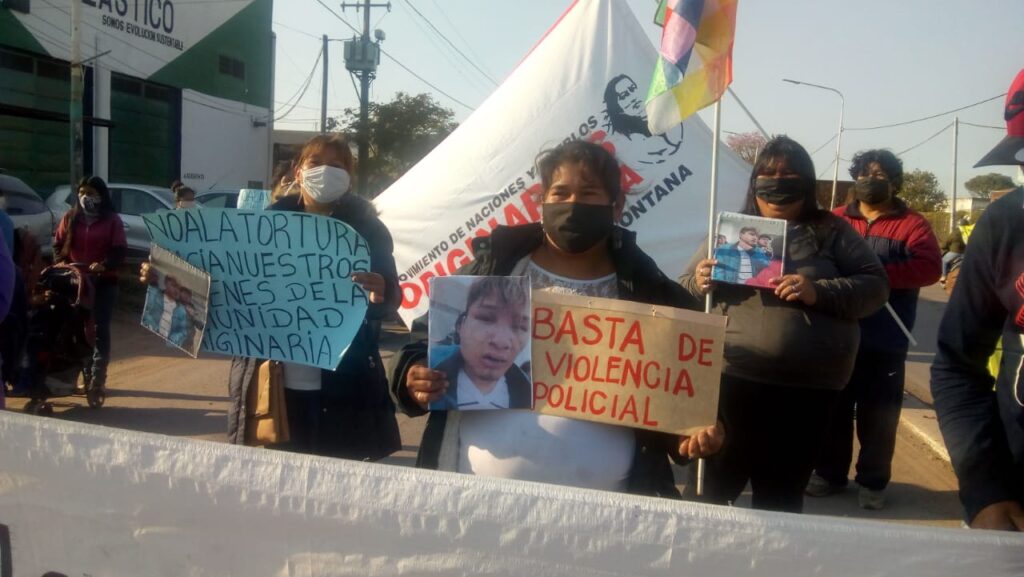
(Left) Silvia Hirsch; Andrea Mastrangelo
Systematic practices of discrimination against indigenous people and working class youth have found an outlet in measures to contain the pandemic in Argentina. This article was originally published in Pandemic Discourses.
On March 20, 2020, the Argentine government declared a strict lockdown as a consequence of the first cases of local transmission of COVID-19 reported in Buenos Aires. While the virus rapidly spread in middle-class neighborhoods of the city, on April 21 the first case in the city’s low-income urban neighborhood of Barrio Mugica was reported. Within a month there were 200 cases in this heavily populated neighborhood.
Similarly, on March 12, the first two cases of COVID-19 were reported in the city of Resistencia, and on April 27, the first case in the Qom indigenous group, who live in this city, was diagnosed. The patient, a young man, died as a result of the infection, and within three weeks there were 90 positive cases in the Area Gran Toba, an agglomeration of urbanized indigenous neighborhoods. From then on, these two heavily working-class neighborhoods populated by many unemployed inhabitants registered an exponential increase in COVID-19 cases and the residents became heavily stigmatized.
“Prejudice and discrimination have increased in the context of fear and uncertainty generated by the pandemic, and violence has been inflicted on subalternized citizens, turning them into scapegoats for the spread of the virus.”
We are an interdisciplinary team of social scientists at the University of San Martin in Buenos Aires. In May we won a research grant to conduct a longitudinal study on the impact of COVID-19 and the lockdown measures known in Argentina as ASPO (Obligatory, Preventive and Social Isolation). The research focuses on the population with unmet needs in housing, tap water and sanitation in the metropolitan areas of Buenos Aires and the city of Resistencia. Buenos Aires is the capital city of the country, the main megapolis of Argentina, and part of the Buenos Aires Province, which has a population of 14 million. Resistencia is the capital of Chaco Province in the northeast region of the country, and is a middle-range urban area with about 400,000 inhabitants.
These are the sites of our fieldwork until December 2020. When we wrote the proposal they were the areas with the largest prevalence of COVID-19. Our research is based both on qualitative and quantitative techniques; we are focusing on neighborhoods that have been classified as having Unmet Basic Needs, a category developed by the United Nations Economic Commission for Latin America and the Caribbean (ECLAC, or CEPAL in Spanish) in the 1980s, which measures lack of access to drinking water, sewage, adequate housing materials and overcrowding. These characteristics found in low-income neighborhoods constrain the ability of inhabitants to adopt necessary measures for the prevention of COVID-19. We have been conducting research in 38 neighborhoods, with the assistance of people who live in the neighborhoods, social movements and a wide range of organizations which include soup kitchens, churches and primary health centers. We also conduct interviews and record data via social media (Facebook, WhatsApp, Google Meet). We are focusing on the experience and point of view of local actors and their everyday life under the restrictions of a long shutdown. Furthermore, we are recording illnesses that are prevalent in the context of the lockdown such as dengue, infectious respiratory, measles.
Two issues that have been particularly relevant in our research, and that have emerged as major concerns, are: institutional violence and stigmatization of residents in terms of ethnicity and social class.
In Argentina, institutional violence is a political and academic category. It shifts the focus from the individuals to the institutions in order to study the institutional and bureaucratic frameworks that legitimize and promote violence in the context of actions which are sometimes presented as exceptional. However, we not only refer to armed and police forces, but also to other institutions which might exert violence, both symbolic and physical, that have deleterious effects on people’s lives.
Prejudice and discrimination have increased in the context of fear and uncertainty generated by the pandemic, and violence has been inflicted on subalternized citizens, turning them into scapegoats for the spread of the virus. Some of the events of institutional violence and discrimination we address have been reported by the media; others were referred to us by affected families and their neighbors. In April, when the virus rapidly spread in the city of Resistencia, the Qom indigenous people were accused by non-indigenous people of having spread the virus, and of having cultural practices that don’t respect sanitary norms. Furthermore, profiling of the population by their phenotype and place of residence led to violent acts of discrimination, such as denying access to health services, entrance to a supermarket, and threats of burning the houses of Qom families.

Members of the Qom community protesting against police violence.
Within weeks rumors emerged that young Qom men were spitting on the door knobs and vehicles of non-indigenous neighbors to make them contract the virus. A particularly violent event took place on May 31, in a neighborhood called Bandera Argentina in the city of Resistencia, where a group of policemen entered a household without a warrant and violently removed four young members of a family. They were taken to the police station where they were beaten up and tortured. Furthermore, the policemen poured alcohol on them and threatened to set them on fire. Two of them are young women who were subjected to sexual abuse. They were accused, without proof, of having thrown stones at the police station. Many of the insults hurled at them by the policemen referred to their indigenous heritage. In the interviews we conducted among Qom men and women, they mentioned structural racism against them as a historical condition which the pandemic exacerbated and events such as these rendered visible.
In the Barrio Mugica neighborhood in Buenos Aires, which has a population of approximately 40,000 and a high level of overcrowding, the virus spread rapidly. Many residents rejected testing, hospitalization and isolation in government-provided hotels as they feared discrimination, both from their own neighbors as well as from institutions. Many families opted for isolating themselves in their homes and avoiding contact with health services.
While these two neighborhoods were a hotspot for the spread of the virus, interventions by the National and County Ministries of Public Health, which ranged from testing to establishing health posts to control symptoms and house visits by health promoters, were successful in substantially reducing the number of cases. In addition, social and political movements have been at the forefront in providing assistance, mostly in the form of soup kitchens and delivering food to residents and assisting the elderly.
Institutional violence by armed forces against young men has been particularly egregious. In a low-income neighborhood of the city of Buenos Aires, a violent case of institutional violence took place on June 17 when a young man called Facundo Scalzo was shot at point blank over an alleged theft by the Gendarmerie patrolling the neighborhood. Several other young men have been killed by armed forces during the lockdown, all of them in low-income neighborhoods.
Several protests took place after the disappearance of 23-year-old Facundo Astudillo. Hitchhiking from the locality of Pedro Luro to the town of Bahia Blanca, he went missing after being stopped and presumably arrested by the police for having violated the lockdown. His disappearance led the Inter-American Commission on Human Rights to lodge a complaint. The Argentine President Alberto Fernández announced that those responsible for his disappearance need to be held accountable. On August 15, his body was found in a state of decomposition, and a forensic exam indicated that it was a death by drowning, but whether it was a result of suicide, homicide or an accident could not be determined.
On June 24, Diego Fidel Chico, a Qom teenager and resident of the Barrio Toba of the city of Resistencia, disappeared. His whereabouts are still unknown.
These events are trends we have systematically observed since we began our research. Racial and class profiling increases institutional violence, particularly among young men, whereby these men are subjected to greater stigmatization by the police, leading to harassment in the streets, incarceration, and cases of shootings at point blank.
In Argentina, grassroots organizations that advocate human rights have a long history of collective action, and victims respond by actively engaging in demands for justice. Moreover, mothers and relatives of victims are often at the forefront of collective responses and actions. This was reinforced in the context of the events we referred to. For instance, the mother of Facundo Scalzo organized a fundraising campaign to hire a judicial expert to provide evidence against the Gendarmerie, and the friends and family of Astudillo organized a major public demonstration during his funeral.
These are some of the events which reveal not only institutional violence, but also a history of stigmatization and discrimination against indigenous and lower-class people, considered by many white and middle-class residents an undesirable presence in cities. The use of force against citizens may have been driven by fear and uncertainty and by the long and demanding lockdown, but these are recurrent and systematic practices of exclusion, and not exceptional events.
Silvia Hirsch is professor and researcher at the Institute for Advanced Social Studies at the University of San Martín, Argentina.
Andrea Mastrangelo is researcher at National Council of Scientific and Technological Research at University of San Martín, Argentina, and National Administration of Laboratories and Institutes of Health, National Ministry of Public Health, Argentina.
